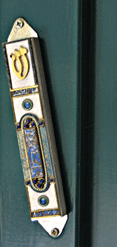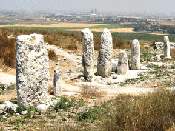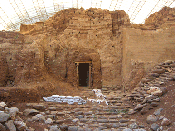|
|
|
 |
|
“THESE WORDS…YOU SHALL WRITE THEM UPON THE
DOORPOSTS OF YOUR HOUSE AND UPON YOUR GATES”
DEUTERONOMY 6
|
|

|
 |
Heading
for the Holy Land? If so, here are 13
expressions you’ll hear and that might get you
scratching your head.
“AUTHENTIC” SITES
are where the majority of scholars believe certain
biblical events actually took place because of
archeological evidence and/or its geographical
location. |
- The Garden of Gethsemane
at the foot of the
Mount of Olives is called an
“authentic” site because it fits the geographical
description.
- The Pool of Bethesda in the Old City of
Jerusalem has both geographical and archeological
evidence.
- Dan, in the north, was positively identified
when an inscription mentioning Dan was found on
the site.
|
|
“TRADITIONAL” SITES
have been rendered holy by pilgrims over the
centuries because they were accessible or they exude
an “authentic atmosphere” – that is, give an idea of
what the site probably looked like in biblical days.
|
- The Upper Room, where Jesus celebrated “The
Last Supper” with his disciples, is a
“traditional” site which has been visited by
pilgrims since the late Middle Ages.
- The Lithostratus, or the Pavement, below the
Sisters of Sion Convent is considered a
“traditional” site, for it’s close to where
Jesus
was judged by Pontius Pilate; it has a “pavement”
mentioned in John 19:13; and it has games on the
floor popular with Roman soldiers of that day.
- The “Ecce Homo” Arch outside the Sister of
Sion Convent was constructed in the second century
AD by the Roman Emperor Hadrian, but is revered as
the place where Pontius Pilate stood over the
crowds and said “Here is the Man!” (John 19:5),
before Jesus was led away to be crucified.
- The Garden Tomb, on
the other hand, is a matter of faith. It’s
believed by some to be a “traditional” site, and
by others to be “authentic.”
|
|
 |
 |
|
Photo:
Gila Yudkin |
Photo:
Gila Yudkin |
|
Pool of Bethesda, an authentic
site |
Ecce Homo Arch, a traditional site |
| |
|
Coming to Jerusalem
this year? Are you coming from very
far away and want every minute to matter?
Would you like to experience both the authentic
and the traditional sites, yet you are most
interested in finding the venues where you can
quietly be transported back in your imagination to
the time of Jesus? David? Abraham?
Make every minute matter while you "Explore
Jerusalem's Soul" with
Gila's Jerusalem Guide.
The up-to-date PDF (Adobe Acrobat) 46-page guide
gives you the Top Ten places to meditate on the
Bible, the Top Ten lesser-known churches worth
visiting, the Top Ten most rewarding roof-top
views and the top Ten places for Middle Eastern
food. More...
|
BCE stands for
Before the Common Era. It refers to exactly
the same time period as BC (Before Christ). In
Israel, where the majority of the population is
either Jewish or Moslem, BCE is commonly used.
CE stands for
Common Era. It’s the equivalent of AD, (After the
Death of Christ or Anno Domini, the year of our
Lord)VIA MARIS
is Latin for “Way of the Sea,” which was the
international coastal highway connecting between the
centers of ancient civilizations – Egypt in the Nile
Valley on the one hand, and Mesopotamia, Babylon and
Assyria, between the Tigris and Euphrates Rivers, on
the other. |
- The Prophet Isaiah mentioned the Way of the
Sea when he spoke of the Galilee of the Gentiles
in chapter 9.
- Isaiah’s prophecy mentioning the Way of the
Sea was to be fulfilled, as Jesus left Nazareth
and settled in Capernaum. (Matthew 4)
|
|
DEAD SEA SCROLLS
are Biblical manuscripts written on animal hide
found in caves in the Judean hills above the Dead
Sea. The first discovery, in 1947, was made by
a Beduin shepherd searching for a lost goat. |
- The
scrolls have shed an enormous amount of
light on the period of the birth of Christianity,
the ministry of John the Baptist, and Second
Temple Judaism.
- Fragments of every book of the Old Testament
were found, except for the Book of Esther.
- Number One on the “Best Seller List” of two
thousand years ago was the Scroll of Isaiah.
|
|
COMING TO
JERUSALEM?
BOOK GILA for a customized private tour |
|
|
|
“MODEST DRESS”
refers to a “cover-up” dress requirement for
many holy places, Jewish, Christian and
Moslem. It usually means no shorts
(for both men and women), no sleeveless tops
and no plunging necklines. Thinner
women can usually get away with more
“immodesty” than their more endowed sisters.
This rule is often enforced arbitrarily by
the guards of the holy places.
|
|
|
But you don't need modest dress to listen to Gila's
one-hour Temple Mount audio tour.
Tour the Temple
Mount in the
company of Abraham and Isaac, David and Solomon,
Jesus and the disciples, the angel Gabriel and
Mohammed -- and Gila. Meet many other luminaries,
both real and legendary.
Gila's Temple Mount tour
is now available as a written
24-page PDF with a
Temple Mount plan,
guidelines for passing the security check
and ten recommended reads on the
Temple Mount from Gila's bookshelves.
|
SHABBAT
is the Hebrew word for the Jewish Sabbath
which begins sundown Friday eve and ends
with the appearance of three stars on
Saturday night.
A SHABBAT ELEVATOR
is found in many Israeli hotels which
include orthodox Jews among their clientele.
On the Jewish Sabbath and Holidays, one
elevator is programmed to stop automatically
on every floor, or if it’s a tall building,
every other floor. This enables
Sabbath-observant Jews, who will not push an
electric button on Shabbat, to reach the
upper floors without climbing the stairs.
|
- This custom originated from an
interpretation of the fourth commandment,
“Remember the Sabbath day to keep it
holy.”
- As the Lord created the universe in
six days and rested from His creative work
on the seventh, so orthodox Jews refrain
from all “creative” work on the Sabbath.
The rabbis have defined pushing a button
to start an elevator as “creative” work.
|
|
BAR MITZVAH
is a coming-of-age ceremony where a
13-year-old Jewish boy reads from the Torah
for the very first time. This is a
happy family occasion which is marked by
singing, dancing, and throwing sweets at the
young man. |
- If you visit the
Western Wall (also
called “The Wailing Wall”) on a Monday or
Thursday morning, you are invited to
observe this ceremony – and gather up some
of the hard candies.
- Don’t forget to congratulate the
parents by saying “Mazal tov!” (Good luck!)
A young girl has a Bat Mitzvah at either
age 12 or 13. On my Bat Mitzvah, I
chanted the haftorah from Joshua
chapter 2, the spy story. For more
about Jericho and to view a segment of my
Hebrew reading, see "Let's
spy out Jericho."
|
|
MEZUZAH
literally means “doorpost.” It is a
decorated rectangular silver, brass,
ceramic, olive wood, or stone box that Jews
attach to the doorpost of their house and
gates.
The box contains parchment inscribed with
biblical verses from the Shm’a (“Hear
O Israel, the Lord Our God, the Lord is
One”) prayer in Deuteronomy 6. Verse 9
says, "And you shall write them upon the
doorposts of your house, and upon your
gates."
On the outside of the box is inscribed
the first letter, shin, or all the Hebrew
letters of Shaddai, the name which the Lord
revealed to Abraham when he offered His
covenant. (Genesis 17)
Look for a mezuzah on the door to
your hotel room. |

Photo:
Gila Yudkin
Mezuzah |
|
|
|
|
KASHRUT
or “keeping kosher” refers to the Jewish
dietary laws of separating between meat
dishes and dairy dishes. The origins are
from Exodus 23:19 “Do not cook a young goat
in its mother’s milk.” |
- Most of Israel’s hotels and many of
its restaurants observe the laws of
kashrut including not serving any milk
products at dinner with chicken or roast
beef.
- Nor would you be offered bacon for
breakfast, ham and cheese for lunch or
pork for dinner. Leviticus 11 lists and
defines “clean” and “unclean” animals.
|
|
SHEKEL is the unit of currency in
Israel. Over the past year, the
conversion rate has fluctuated between 3.7
to 4.2 shekels to one US dollar. The word
shekel is mentioned in the Bible as a unit
of weight.
|
- Abraham bought the Cave of the
Machpela in Hebron to use as a burial
place for his wife Sarah for 400 shekels
of silver. (Gen 23:15) This was
an
exorbitant price. According to the
Hammurabi code, the annual income of the
“man in the street” was the equivalent of
six or eight shekels.
- David bought the threshing floor of
Araunah for 50 shekels of silver.
This was where he decided to build the
Temple.
- In Jesus day, the Tyrian shekel was
the most stable unit of currency and used
for payment of the temple tax.
"Go to the lake and cast a
hook;
take the first fish that bites,
Open its mouth and there
you will find a shekel." |
 |
|
(Matt 17:27) |
Photo:
Gila Yudkin |
|
|
Suzanne finds a shekel! |
|
If you encountered other expressions during
your pilgrimage which you recommend should
be included in “Holy Land Jargon” to help
future pilgrims, please
contact me. |
|
|
|
Copyright 2006,
2011
Gila Yudkin. Permission needed for any reuse. |
|
|
|
Don't miss these biblical
sites: |
|
|
 |
 |
 |
|
Gezer
|
Beth Shean |
Hazor |
| |
|
|
|
 |
 |
 |
|
Dan
|
Herodion |
Azekah / Valley of
Elah |
|
|
|
|
How
to lead a tour that's a rave success! |
|
|
|
FAQ on
Hezekiah's Tunnel |
|
|
|
Mount of
Olives: FUN things to DO |
|
|
|
Mark
Twain's Holy Land Tips |
|
|
|
10 Tips
for a Terrific Temple Mount Tour |
|
|
|
|
|
|
GILA
YUDKIN
•
TCHERNIKOVSKI
64A
•
JERUSALEM
•
ISRAEL
gila@itsgila.com
HOME
•
HOLY
LAND
HEROINES
•
SONGS
& PRAISE •
ABOUT GILA
|
|

